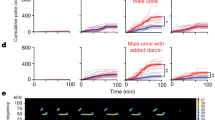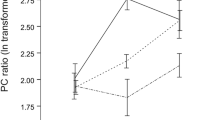Abstract
In rodents, urine-borne male pheromones include volatile organic compounds (VOCs) and major urinary proteins (MUPs). In mice, the attraction of females to male odor is reportedly acquired through associative learning with MUPs in some studies. Here, we found that VOC and MUP sex pheromones were differentiated in rats at around 8 weeks of age and that females separated from males at weaning showed no preference for male urine odor after sexual maturity. Olfactory preferences could be gained in females after repeated experience of VOC pheromones alone as well as male urine or a blend of synthetic VOC pheromones and recombinant MUPs. However, differences in acquired olfactory preferences for male urine were further revealed by neuro-immuno-histochemical studies. The blend exhibited neural activation in the main olfactory system (MOS), accessory system (AOS), and the ventromedial hypothalamus (VMH), indicating sexual arousal, whereas the VOC alone only caused neural activation of MOS. We suggest that olfactory preference is generated through repeated experience of either VOCs or a blend of VOCs and MUPs, but the neural activations related to sexual arousal have to be acquired through associative learning with MUPs in female rats.
Significance statement
When adult female rats were separated from males before maturity, they lost their attraction to male urine odor. Female preference to volatiles in male urine could be gained by repeated experience of volatile and protein pheromones. Brain regions related to sexual arousal were activated by male urine in females with experience of VOCs together with MUPs but not in those experienced with VOCs alone. Associative learning between VOC and MUP pheromones is necessary for male urine odor-induced FOS responses in the key regions for sexual arousal/excitement in female rats.



Similar content being viewed by others
References
Asaba A, Hattori T, Mogi K, Kikusui T (2014) Sexual attractiveness of male chemicals and vocalizations in mice. Front Neurosci 8:231
Bekkers JM, Suzuki N (2013) Neurons and circuits for odor processing in the piriform cortex. Trends Neurosci 36:429–438
Beny Y, Kimchi T (2014) Innate and learned aspects of pheromone-mediated social behaviours. Anim Behav 97:301–311
Boschat C, Pelofi C, Randin O, Roppolo D, Luscher C, Broillet MC, Rodriguez I (2002) Pheromone detection mediated by a V1r vomeronasal receptor. Nat Neurosci 5:1261–1262
Brennan PA, Kendrick KM (2006) Mammalian social odours: attraction and individual recognition. Philos Trans R Soc B 361:2061–2078
Brennan PA, Zufall F (2006) Pheromonal communication in vertebrates. Nature 444:308–315
Coria-Avila GA, Pfaus JG (2007) Neuronal activation by stimuli that predict sexual reward in female rats. Neuroscience 148:623–632
Cummings JA, Becker JB (2012) Quantitative assessment of female sexual motivation in the rat: hormonal control of motivation. J Neurosci Methods 204:227–233
Dulac C, Kimchi T (2007) Neural mechanisms underlying sex-specific behaviors in vertebrates. Curr Opin Neurobiol 17:675–683
Flanagan-Cato LM (2011) Sex differences in the neural circuit that mediates female sexual receptivity. Front Neuroendocrinol 32:124–136
Ferrero DM, Moeller LM, Osakada T, Horio N, Li Q, Roy DS, Cichy A, Spehr M, Touhara K, Liberles SD (2013) A juvenile mouse pheromone inhibits sexual behaviour through the vomeronasal system. Nature 502:368–371
Gómez-Baena G, Armstrong SD, Phelan MM, Hurst JL, Beynon RJ (2014) The major urinary protein system in the rat. Biochem Soc Trans 42:886–892
Griffiths PR, Brennan PA (2015) Roles for learning in mammalian chemosensory responses. Horm Behav 68:91–102
Guo X, Guo H, Zhao L, Zhang YH, Zhang JX (2018) Two predominant MUPs, OBP3 and MUP13, are male pheromones in rats. Front Zool 15:6
Haga S, Hattori T, Sato T, Sato K, Matsuda S, Kobayakawa R, Sakano H, Yoshihara Y, Kikusui T, Touhara K (2010) The male mouse pheromone ESP1 enhances female sexual receptive behaviour through a specific vomeronasal receptor. Nature 466:118–122
Ishii KK, Osakada T, Mori H, Miyasaka N, Yoshihara Y, Miyamichi K, Touhara K (2017) A labeled-line neural circuit for pheromone-mediated sexual behaviors in mice. Neuron 95:123–137
Kang N, Baum MJ, Cherry JA (2009) A direct main olfactory bulb projection to the 'vomeronasal' amygdala in female mice selectively responds to volatile pheromones from males. Eur J Neurosci 29:624–634
Kimchi T, Xu J, Dulac C (2007) A functional circuit underlying male sexual behaviour in the female mouse brain. Nature 448:1009–1014
Kippin TE, Cain SW, Pfaus JG (2003) Estrous odors and sexually conditioned neutral odors activate separate neural pathways in the male rat. Neuroscience 117:971–979
Leinders-Zufall T, Lane AP, Puche AC, Ma WD, Novotny MV, Shipley MT, Zufall F (2000) Ultrasensitive pheromone detection by mammalian vomeronasal neurons. Nature 405:792–796
Liu YJ, Guo HF, Zhang JX, Zhang YH (2017) Quantitative inheritance of volatile pheromones and darcin and their interaction in olfactory preferences of female mice. Sci Rep 7:2094
Luo M, Fee MS, Katz LC (2003) Encoding pheromonal signals in the accessory olfactory bulb of behaving mice. Science 299:1196–1201
Maekawa F, Tsukahara S, Kawashima T, Nohara K, Ohki-Hamazaki H (2014) The mechanisms underlying sexual differentiation of behavior and physiology in mammals and birds: relative contributions of sex steroids and sex chromosomes. Front Neurosci 8:242
Moncho-Bogani J, Lanuza E, Hernandez A, Novejarque A, Martinez-Garcia F (2002) Attractive properties of sexual pheromones in mice: innate or learned? Physiol Behav 77:167–176
Moncho-Bogani J, Martinez-Garcia F, Novejarque A, Lanuza E (2005) Attraction to sexual pheromones and associated odorants in female mice involves activation of the reward system and basolateral amygdala. Eur J Neurosci 21:2186–2198
Nomoto K, Lima SQ (2015) Enhanced male-evoked responses in the ventromedial hypothalamus of sexually receptive female mice. Curr Biol 25:589–594
Novotny MV (2003) Pheromones, binding proteins and receptor responses in rodents. Biochem Soc Trans 31:117–122
Oboti L, Schellino R, Giachino C, Chamero P, Pyrski M, Leinders-Zufall T, Zufall F, Fasolo A, Peretto P (2011) Newborn interneurons in the accessory olfactory bulb promote mate recognition in female mice. Front Neurosci 5:113
Pardo-Bellver C, Martinez-Bellver S, Martinez-Garcia F, Lanuza E, Teruel-Marti V (2017) Synchronized activity in the main and accessory olfactory bulbs and vomeronasal amygdala elicited by chemical signals in freely behaving mice. Sci Rep 7:9924
Paxinos G, Watson C (2006) The rat brain in stereotaxic coordinates. Academic press, London
Ramm SA, Cheetham SA, Hurst JL (2008) Encoding choosiness: female attraction requires prior physical contact with individual male scents in mice. Proc R Soc Lond B 275:1727–1735
Roberts SA, Davidson AJ, Beynon RJ, Hurst JL (2014) Female attraction to male scent and associative learning: the house mouse as a mammalian model. Anim Behav 97:313–321
Roberts SA, Davidson AJ, McLean L, Beynon RJ, Hurst JL (2012) Pheromonal induction of spatial learning in mice. Science 338:1462–1465
Roberts SA, Simpson DM, Armstrong SD, Davidson AJ, Robertson DH, McLean L, Beynon RJ, Hurst JL (2010) Darcin: a male pheromone that stimulates female memory and sexual attraction to an individual male's odour. BMC Biol 8:75
Robinson TE, Berridge KC (2008) The incentive sensitization theory of addiction: some current issues. Philos Trans R Soc B 363:3137–3146
Rolls ET (2015) Taste, olfactory, and food reward value processing in the brain. Prog Neurobiol 127:64–90
Romero PR, Beltramino CA, Carrer HF (1990) Participation of the olfactory system in the control of approach behavior of the female rat to the male. Physiol Behav 47:685–690
Spiteri T, Musatov S, Ogawa S, Ribeiro A, Pfaff DW, Agmo A (2010) Estrogen-induced sexual incentive motivation, proceptivity and receptivity depend on a functional estrogen receptor alpha in the ventromedial nucleus of the hypothalamus but not in the amygdala. Neuroendocrinology 91:142–154
Tachikawa KS, Yoshihara Y, Kuroda KO (2013) Behavioral transition from attack to parenting in male mice: a crucial role of the vomeronasal system. J Neurosci 33:5120–5126
Treloar HB, Miller AM, Ray A, Greer CA (2010) Development of the olfactory system. In: Menini A (ed) Neurobiology of olfaction. CRC Press, Boca Raton, pp 131–156
Wang ZS, Sindreu CB, Li V, Nudelman A, Chan GCK, Storm DR (2006) Pheromone detection in male mice depends on signaling through the type 3 adenylyl cyclase in the main olfactory epithelium. J Neurosci 26:7375–7379
Wysocki CJ, Bean NJ, Beauchamp GK (1986) The mammalian vomeronasal system: its role in learning and social behaviors. In: Duvall D, Müller-Schwarze D, Silverstein RM (eds) Chemical signals in vertebrates 4. Springer, Boston, pp 471–485
Xu FQ, Schaefer M, Kida I, Schafer J, Liu N, Rothman DL, Hyder F, Restrepo D, Shepherd GM (2005) Simultaneous activation of mouse main and accessory olfactory bulbs by odors or pheromones. J Comp Neurol 489:491–500
Yoshikawa K, Nakagawa H, Mori N, Watanabe H, Touhara K (2013) An unsaturated aliphatic alcohol as a natural ligand for a mouse odorant receptor. Nat Chem Biol 9:160–162
Zhang JX, Sun LX, Zhang JH, Feng ZY (2008) Sex- and gonad-affecting scent compounds and 3 male pheromones in the rat. Chem Senses 33:611–621
Zhang YH, Zhang JX (2011) Urine-derived key volatiles may signal genetic relatedness in male rats. Chem Senses 36:125–135
Zhang YH, Zhang JX (2014) A male pheromone-mediated trade-off between female preferences for genetic compatibility and sexual attractiveness in rats. Front Zool 11:73
Acknowledgments
We thank BeiJing Zixi Biotechnology Co., Ltd. for expression and purification of the recombinant MUPs. We thank the editors and the two anonymous reviewers for their constructive comments and suggestions which helped to improve this manuscript.
Funding
This work was supported by grants from the Strategic Priority Research Program of the Chinese Academy of Sciences (No. XDB11010400), the National Natural Science Foundation of China (Nos. 31572277 and 31672306), and the Foundation of State Key Laboratory of IPM (ChineseIPM1701).
Author information
Authors and Affiliations
Contributions
JXZ and YHZ conceived and designed the experiments. YHZ and JHZ performed the behavioral experiments and GC-MS analysis. MMT performed c-Fos immunohistochemistry. XG and XRG performed the SDS-PAGE analysis and prepared the MUPs. YHZ, MMT, and JXZ wrote the paper. All authors read and approved the final manuscript.
Corresponding authors
Ethics declarations
Conflict of interest
The authors declare that they have no competing interests.
Ethical approval
All procedures performed in studies involving animals were in accordance with the ethical standards of the institution (Institutional Guidelines for Animal Use and Care at the Institute of Zoology, the Chinese Academy of Sciences, IOZ 2015) or practice at which the studies were conducted.
Data availability statements
All data generated or analyzed during this study are included in this published article [and its supplementary information files].
Additional information
Communicated by A. I. Schulte-Hostedde
Publisher’s note
Springer Nature remains neutral with regard to jurisdictional claims in published maps and institutional affiliations.
Rights and permissions
About this article
Cite this article
Zhang, YH., Tang, MM., Guo, X. et al. Associative learning is necessary for airborne pheromones to activate sexual arousal-linked brain areas of female rats. Behav Ecol Sociobiol 73, 75 (2019). https://doi.org/10.1007/s00265-019-2685-9
Received:
Revised:
Accepted:
Published:
DOI: https://doi.org/10.1007/s00265-019-2685-9




